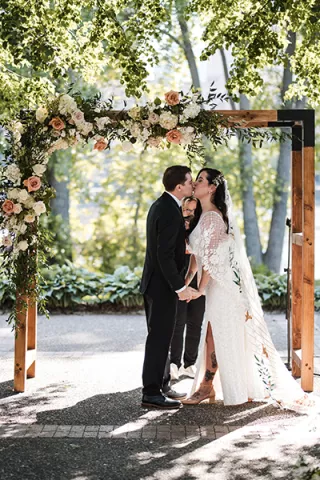Ask any married American woman who changed her name post-wedding, and she’ll (likely) tell you it was a pain in the neck. It’s an administrative task few embrace with the enthusiasm of planning a honeymoon or picking a China pattern – and for good reason. The list of places requiring the newlywed to file a name change is daunting, ranging from the Social Security Administration to the auto insurance company, and just about everywhere in between. Moreover, brides are required to apply for a drivers’ license and passport bearing their new name.
Considering all these hassles (and for other more idealistic and/or personal reasons), it’s not surprising that a number of women are opting to retain their birth surname, or hyphenating theirs and their husband’s last names, thereby ensuring that both sides of the family will be equally represented in the last name of subsequent children. Still, many new wives prefer to adhere to tradition – taking their husband’s name immediately upon marriage.
So where did this custom come from, and why does society insist on thrusting it on new brides, despite enormous advancements in gender equality and women’s rights? While there is no law in the United States requiring a name change after marriage, the tradition is still very much alive and well, thanks in part to its historical underpinnings in English (and subsequently American) common law.
How it all started
Historically, a person’s surname was not considered all that important. In early medieval England, most people were known only by one name, their “Christian name,” such as Thomas or Anne, which was conferred at baptism. But as the population grew, it got tiresome trying to distinguish among the many Thomases or Annes (or Richards or Marys), so surnames arose, often based on lineage (such Williamson), occupation (such as Smith), or locale (such as York).
Still, the matter of a wife taking a husband’s surname didn’t surface in English common law until the ninth century, when lawmakers began to consider the legalities surrounding personhood, families, and marriage. Thusly (as they would say), the doctrine of coverture emerged – and women were thereafter considered “one” with their husbands and therefore required to assume the husband’s surname as their own.
Under the concept of coverture, which literally means “covered by,” women had no independent legal identity apart from their spouse. Actually, this “coverage” began upon the birth of a female baby – who was given her father’s surname – and could only change upon the marriage of that female, at which point her name was automatically changed to that of her new husband.
But coverture laws also prevented women from entering into contracts, engaging in litigation, participating in business, or exercising ownership over real estate or personal property. As succinctly stated by former Justice Abe Fortas of the United States Supreme Court in United States v. Yazell, “[c]overture… rests on the old common-law fiction that the husband and wife are one, [and] the one is the husband.”
Evolutions in the law
Not surprisingly, women in the United States began to take exception to their non-existent legal status, and a much-needed feminist uprising occurred concurrently with the passage of Married Women’s Property Acts in several U.S. states in the mid-1800s. Under these acts, women gained individual legal status for purposes of signing contracts, engaging in business and commerce, and making purchases to acquire property. Accordingly, now that the woman’s name had its own independent legal significance, the number of women opting to retain their birth name began to rise.
From there, the law continued to catch up…slowly. It wasn’t until the 1970s that the U.S. Supreme Court struck down a Tennessee law requiring a woman to assume the last name of her husband before registering to vote. Around the same time, the prefix “Ms.” emerged, allowing women to assert their identity apart from their marital status.
Today, an estimated 20 percent of American women opt to retain their birth name after marriage – actually alower percentage than in the 1970s and 1980s. Back then, many women saw keeping their birth name as an equality issue – a repudiation of any vestiges of coverture. For today’s brides, however, the choice is often practical or rooted in professional identity.
With the marriage landscape finally expanded to include same-sex couples, the future of married surnames remains to be seen (and as attitudes continue to evolve around gay marriage, consensus on the matter likely isn’t forthcoming anytime soon). While many newlyweds choose to retain their birth name, some couples have opted for the non-traditional route of combining parts of both surnames to create a totally new identity – much to the delight of the makers of monogrammed clothing and accessories.
Stephanie Reid obtained her J.D. from Regent University School of Law and her Bachelor of Arts degree from Florida State University. After two years in private practice, Stephanie has opened her own law firm, Stephanie Reid Law. Her practice offers innovative web-based legal services for estate planning, family law and business clients. Stephanie also writes for AvvoStories, brought to you by Avvo, the leading online legal marketplace connecting consumers and lawyers. Avvo’s free Q&A forum with more than 9 million questions and answers, along with on-demand legal services that provide professional counsel for a fixed cost, make legal faster and easier.















